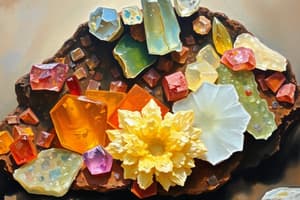Podcast
Questions and Answers
What can happen if you submit an incomplete lab?
What can happen if you submit an incomplete lab?
- You are not allowed to redo the lab
- You will receive full credit for effort
- You may lose points on your overall grade (correct)
- You will automatically pass the course
What is one aspect you should consider when identifying a mineral?
What is one aspect you should consider when identifying a mineral?
- The location where the mineral was found
- The color of the mineral only
- The cost of the mineral in the market
- The physical properties and characteristics (correct)
How does density relate to mineral identification?
How does density relate to mineral identification?
- Density is unrelated to physical properties
- Density is the only property that matters
- Density varies greatly among minerals, making it unreliable
- Density helps differentiate minerals based on weight (correct)
Which of the following is NOT a factor in identifying a mineral?
Which of the following is NOT a factor in identifying a mineral?
What will be highlighted in red when reviewing your density lab?
What will be highlighted in red when reviewing your density lab?
Flashcards are hidden until you start studying
Study Notes
Properties of Minerals
- Minerals are naturally occurring, inorganic solids with a definite chemical composition and crystalline structure.
- Common properties used to identify minerals include hardness, luster, color, streak, cleavage, fracture, density, and specific gravity.
Identifying Minerals
- Hardness measures a mineral's resistance to scratching, often evaluated using Mohs hardness scale.
- Luster describes how a mineral reflects light; categorized as metallic or non-metallic.
- Color is a visible characteristic but can be misleading due to impurities; streak test involves scraping a mineral on porcelain to reveal its powder color.
- Cleavage refers to the tendency of a mineral to break along flat surfaces, while fracture describes an uneven break.
Density Lab Importance
- Completing labs accurately is crucial; points are deducted for incomplete submissions.
- Pay special attention to highlighted sections in your lab, particularly involving density measurements.
Studying That Suits You
Use AI to generate personalized quizzes and flashcards to suit your learning preferences.




